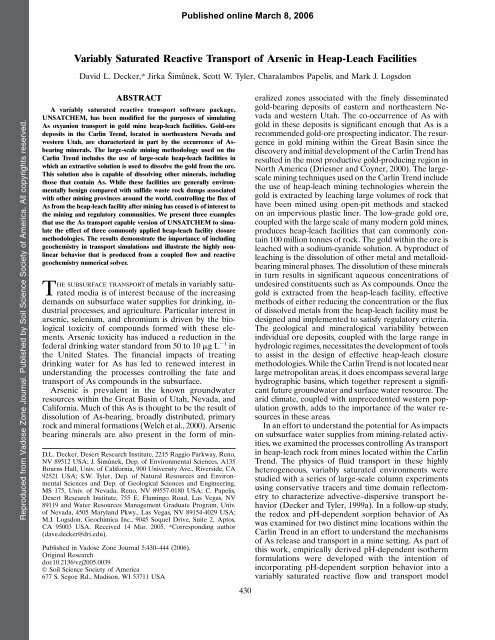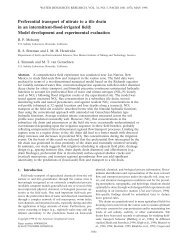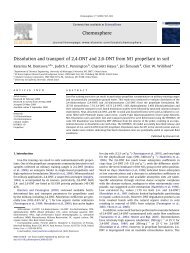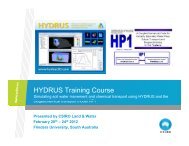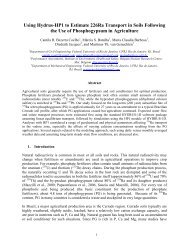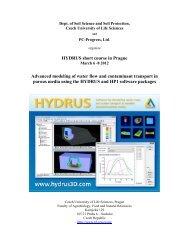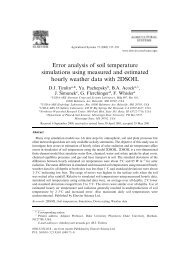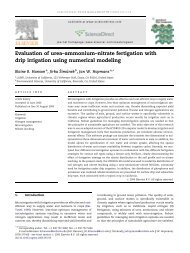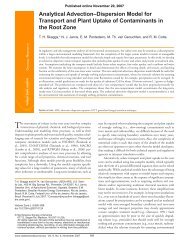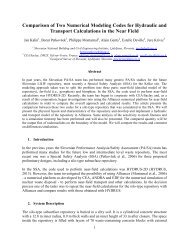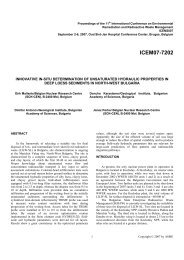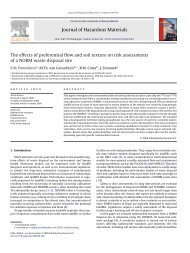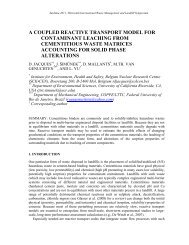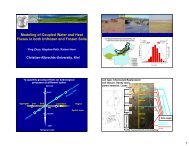Full Text (PDF) - Soil Science Society of America
Full Text (PDF) - Soil Science Society of America
Full Text (PDF) - Soil Science Society of America
- No tags were found...
Create successful ePaper yourself
Turn your PDF publications into a flip-book with our unique Google optimized e-Paper software.
www.vadosezonejournal.org433Reproduced from Vadose Zone Journal. Published by <strong>Soil</strong> <strong>Science</strong> <strong>Society</strong> <strong>of</strong> <strong>America</strong>. All copyrights reserved.Aqueous Complexation ReactionsTable 3. Arsenic aqueous complex thermodynamic values(Appelo and Postma, 1993; Welch and Stollenwerk, 2003).The set <strong>of</strong> As aqueous complexes that has been addedComplexation Reaction Log K Dh r (kcal molto the geochemical database built into UNSATCHEM)Arsenian Pyrite–FeAs x S 2-x (0 , X , 1)Sorbed speciesAs(III), As(V)for which the rate <strong>of</strong> iron hydroxide precipitation is expressedin moles per second at 208C (Langmuir, 1997).O 2 species P O2is given in Table 2; the values <strong>of</strong> the thermodynamicH 3 As (III) O 3 W H 2 As (III) O 32 1 H 1 29.228 6.56H 3 As (III) O 3 W HAs (III) Oparameters associated with these reactions are given in3 1 2H 1 221.33 14.19932H 3 As (III) O 3 W As (III) O 3 1 3H 1 234.744 20.25Table 3. Since these complexes affect the overall mass H 3 As (V) O 4 W H 2 As (V) O 2 4 1 H 1 22.243 21.69Hbalance, two additional equations for the two As oxidationstates considered are3 As (V) O 4 W HAs (V) O 22 4 1 2H 1 29.1 20.92H 3 As (V) O 4 W As (V) O 32 4 1 3H 1 220.597 3.43As(III) T5 [H 2 AsO 2 ] 1 3 [HAsO22]3 [AsO32]31 [H 3 AsO o ] [13] 8.3 (Krauskopf and Bird, 1995). Because <strong>of</strong> this high3 pH environment, the dissolution <strong>of</strong> pyrite by Fe 31 isAs(V) T5 [H 2 AsO 2 ] 1 4 [HAsO22]4 [AsO32]minimized as a result <strong>of</strong> the rapid precipitation <strong>of</strong> Fe 314 to Fe(OH) 3 by the following reaction:1 [H 3 AsO o ] [14]4where variables with the subscript T represent the totalFe 31 1 1 O 2 1 5 H 4 22O!Fe(OH) 31 2H 1 [19]analytical concentrations in solution <strong>of</strong> the particularspecies, and where the brackets refer to molalities (molkg 21 ). In addition to these mass-balance equations, theoverall charge-balance equation, including As complexes,is expressed aswhich, in the flow-through environment <strong>of</strong> the heapleachfacility, is assumed to be irreversible. Therefore,the reactions given in Eq. [17] and [18] are ignored, andthe primary dissolution reaction for pyrite in CarlinTrend type deposits, as given in Eq. [16], is controlled by2[Ca 21 ] 1 2[Mg 21 ] 1 [Na 1 ] 1 [K 1 ] 1 [CaHCO 1 ] the availability <strong>of</strong> O 2 .3The acidity generated from the oxidation <strong>of</strong> pyrite1 [MgHCO 1 ] 1 3 [H1 ] 2 2[CO 22 3 [HCO2] 2 3 2[SO22]4 (Eq. [16]) and the hydrolysis <strong>of</strong> ferric iron (Eq. [18]) is2 [Cl 2 ] 2 [OH 2 ] 2 [NaCO 2 ] 2 3 [NaSO2] 2 4 [KSO2]buffered by the dissolution <strong>of</strong> calcite and the precipitation<strong>of</strong> gypsum. In Carlin Trend heap-leach facilities, the42 [H 2 AsO 2 ] 2 3 2[HAsO22]3 3[AsO32]3 2AsO 2 ] 4 amount <strong>of</strong> carbonate mass far exceeds the total mass <strong>of</strong>2 2[HAsO 22 4 3[AsO32 4] 5 0 [15] sulfides in the heap, and a high pH environment shouldprevail at all times.Simulating the oxidation <strong>of</strong> pyrite and the precipitation<strong>of</strong> ferric hydroxide requires the inclusion <strong>of</strong> kineticPrecipitation–Dissolution ReactionsInorganic pyrite dissolution is described by a series <strong>of</strong>reactions that encompass a wide pH range. These reactionsare commonly written as (Langmuir, 1997)versions <strong>of</strong> these reactions. An experimental rate lawfor Eq. [16] was determined in a stirred reactor in acontrolled laboratory environment, and is given byFeS 2 1 7 O (Williamson and Rimstidt, 1994) as2 1 H2 2 O W Fe 21 1 2SO 2241 2H 1 [16]d(FeS 2 )FeS 2 1 14Fe 31 1 8H 2 O W 15Fe 21 1 2SO 2241 16H 15 10 (mO 2) 0:528:10 [20]dt(mH 1 ) 0:11[17]where the rate <strong>of</strong> pyrite dissolution is expressed in molesFe 21 1 1 O 2 1 H 1 W Fe 31 1 1 H 4 22O [18] per square meter per second. This rate law is particularlyuseful to the present modeling effort, as it depends onlyThe Carlin Trend heaps represent a somewhat unique on pO 2 and pH. An alternative rate law for pyriteenvironment to describe pyrite oxidation due to the oxidation in moist air proposed by Jerz and Rimstidtpresence <strong>of</strong> significant amounts <strong>of</strong> carbonate minerals (2004) is <strong>of</strong> interest because it is conceptually applicablerelative to the low mass percentages <strong>of</strong> sulfide minerals. to a variably saturated environment. The Jerz andThe equilibrium pH for the solution in equilibrium withboth gypsum and calcite minerals varies between 7.8 andRimstidt (2004) experiment was performed under stagnantflow conditions and with initially unoxidized pyrite.These experimental conditions are not analogousto a field-scale heap-leach facility, and therefore theTable 2. Components added to UNSATCHEM to simulate Asgeochemistry.Williamson and Rimstidt (1994) rate expression is incorporatedinto UNSATCHEM.Component typeComponentsAt high pH, Fe(OH) 3 is relatively insoluble, andAqueous ions As 31 ,As 51 ,Fe 21precipitates by Eq. [19]. An empirical rate law for this22 32AqueousH 2 AsO 32 ,H 3 AsO°, 3 HAsO 3 , AsO 3 ,H 2 AsO 42 ,complexesHAsO 22 4 , AsO 32 4 ,H 3 AsO°4reaction is given byMineral species Fe(OH) 3Pyrite minerals:d[Fe(OH) 3]5 210 25:98 (Fe21 )Pyrite–FeSdt(H 1 ) P 22 O2Arsenopyrite–FeAsS[21]
434 VADOSE ZONE J., VOL. 5, FEBRUARY 2006Reproduced from Vadose Zone Journal. Published by <strong>Soil</strong> <strong>Science</strong> <strong>Society</strong> <strong>of</strong> <strong>America</strong>. All copyrights reserved.The occurrence <strong>of</strong> As as a minor constituent in pyriteis a possibility and has been documented in preciousmetals heaps around the world (Jambor, 1994). The oxidation<strong>of</strong> arsenian pyrite can be written asFeAs x S 22x 1 ð 7 2 22x Þ O 2 1 H 2 O!Fe 12 1 (22x)SO 2241 2H 1 1xAs aq [22]where x is the fraction <strong>of</strong> As present in pyrite. Note thatsetting x 5 0 results in the pyrite oxidation reactiongiven in Eq. [16], and setting x 5 1 results in a representationfor the oxidation <strong>of</strong> the mineral arsenopyrite,FeAsS. The generalized reaction in Eq. [22] is includedin UNSATCHEM as a master equation for pyrite, arsenopyrite,and arsenian pyrite oxidation and is invokedby specifying the As fraction as an input parameter. Thedissolution rate for this reaction is assumed to proceedunder the same rate law as pure-phase pyrite as given inEq. [20].Arsenic SorptionThe partitioning <strong>of</strong> As mass between the aqueous andsorbed phases is accomplished using the two pHdependentisotherm expressions described in Deckeret al. (2006). The first expression is a Sips-type, orLangmuir–Freundlich, isotherm that is pH dependent.1 (a S C e ) nSq e 5 q m [23]1 1 de 2epH 1 1 (a S C e ) nSThis expression encompasses two analytically measuredparameters, C e and pH, and one calculated parameter,q e . There are three isotherm-fitting parametersfrom the Sips formulation, q m , n s , and a s , and incorporatingpH dependence adds two additional fitting parameters,d and e. The simulations included in this studysimplified this model to a Langmuir form by assigningn s 5 1. In addition, a Keren-type pH-dependent isothermis also incorporated into UNSATCHEMK L C eq e 5 q m1 1 K L C eA 1 B 3 10 (pH214)K L 5[24]1 1 C 3 10 (pH214) 1 D 3 [10 (pH214) ] 2where A, B, C, and D are empirically determinedconstants.Oxygen TransportA critical component to modeling As sorption isincluding redox chemistry to enable speciating As inboth the aqueous and sorbed phases. The experimentalsorption results given in Decker et al. (2006) demonstratethat the sorption behavior <strong>of</strong> As(III) and As(V)exhibits significant pH dependence. The speciation <strong>of</strong>As(III) and As(V) is controlled by redox chemistry.Therefore, a reactive transport model for As should beinclusive <strong>of</strong> redox processes. The inclusion <strong>of</strong> redoxchemistry is particularly important to a realistic inclusion<strong>of</strong> both As(III) and As(V) sorption behavior.Water chemistry data for the two facilities were neitheravailable nor obtainable due to the anonymous nature <strong>of</strong>the donations <strong>of</strong> rock material from the mining industry.Therefore, a surrogate redox chemistry approach wastaken. An approximation <strong>of</strong> the redox potential can bemade through dissolved oxygen concentration in thatreducing conditions are characterized by low oxygen concentrations,and oxidizing conditions are characterizedby relatively higher oxygen concentrations. This generalizedredox chemistry approach is incorporated intoUNSATCHEM for the singular purpose <strong>of</strong> controllingthe oxidation state <strong>of</strong> As. In practice, this is accomplishedby specifying the critical oxygen concentration that definesthe threshold between oxidizing and reducing conditionsas an input variable. This variable in turn is used todetermine the speciation <strong>of</strong> As on a node-by-node basisat each time step. Arsenic speciation is allowed to proceedthrough this oxygen surrogate in a reversible manner.The use <strong>of</strong> oxygen and iron as a redox surrogate tocontrol As redox chemistry presumes that the geochemistryassociated with Fe, O 2 , and As is coupled. In thepresence <strong>of</strong> sulfide mineralogy, this assumption isprobably reasonable since the coupled interaction <strong>of</strong> O 2and Fe drives the redox chemistry. However, in theabsence <strong>of</strong> sulfide mineralogy, the use <strong>of</strong> the partialpressure for O 2 may not be a satisfactory redox surrogatefor As, and explicit As redox chemistry may need to beincorporated into UNSATCHEM to adequately representthis type <strong>of</strong> domain. The Carlin Trend ore depositsare associated with sulfide mineralogy, and therefore theassumption is made that the use <strong>of</strong> O 2 is a reasonablesurrogate representation <strong>of</strong> the complex redox chemistryfor As.The oxygen transport modeling approach is similar tothat used for carbon dioxide transport (Šimůnek andSuarez, 1993). The gas transport mass conservationequation is]C T]t5 2 ]]z (J da 1 J dw 1 J ca 1 J cw ) 1 P [25]where J da describes the O 2 flux caused by diffusion in thegas phase, J dw is the O 2 flux caused by dispersion in thedissolved phase, J ca is the O 2 flux caused by convectionin the gas phase, and J cw is the O 2 flux caused byconvection in the dissolved phase. The term C T is thetotal volumetric concentration <strong>of</strong> O 2 , and P is a source–sink term. These terms are defined asJ da 5 2u a D a]C a]zJ dw 5 2u w D w]C w]zJ ca 5 q a C aJ cw 5 q w C wC T 5 C a u a 1 C w u a [26]where C w and C a are the volumetric concentrations <strong>of</strong>O 2 in the dissolved and gas phases, respectively, D a isthe effective soil matrix diffusion coefficient <strong>of</strong> O 2 in the
www.vadosezonejournal.org435Reproduced from Vadose Zone Journal. Published by <strong>Soil</strong> <strong>Science</strong> <strong>Society</strong> <strong>of</strong> <strong>America</strong>. All copyrights reserved.gas phase, D w is the effective soil matrix dispersioncoefficient <strong>of</strong> O 2 in the dissolved phase, q a is the soil airflux, q w is the soil water flux, and u a is the volumetric aircontent. Since UNSATCHEM does not consider coupledwater and air movement, the flux <strong>of</strong> air, q a , isunknown, and thus must be approximated somehowusing additional assumptions. One possibility is to assumethat the advective transport <strong>of</strong> O 2 in response tothe total pressure gradient is negligible compared withO 2 diffusion, and therefore to assume a stagnant gasphase in which only diffusive transport occurs (q a 5 0).Another possibility is to assume that because <strong>of</strong> themuch lower viscosity <strong>of</strong> air in comparison with water, arelatively small pressure gradient will lead to significantgas flow. Changes in the total volume <strong>of</strong> water in the soilpr<strong>of</strong>ile caused by water flow are thus assumed to beimmediately matched by corresponding changes in thegas volume, leading to air fluxes. This simple model thustakes into account “rainfall effects” on soil aeration,which was estimated to contribute about 7 to 9% <strong>of</strong> normalaeration (Jury and Horton, 2004). Jury and Horton(2004) also stated that other factors, such as wind, barometricpressure changes, and temperature effects, donot contribute to more than about 1% <strong>of</strong> normal aeration,and thus may be neglected in the majority <strong>of</strong> applications.Although the modified UNSATCHEM modelcan consider simplified gas convection, the examplesgiven in this paper are run under steady-state, constantfluid flux conditions. Therefore, the contribution to thetotal oxygen flux from convection in the air phaseis neglected.Sulfide waste rock dumps in other mining districtsaround the world can contain sulfide mass fractions <strong>of</strong> 2to 30% (Ritchie, 1994). In some <strong>of</strong> these cases, convectiveoxygen flux is known to substantially contributeto the overall oxygen mass budget as a result <strong>of</strong> theexothermic heat <strong>of</strong> reaction produced from the dissolution<strong>of</strong> sulfides (Ritchie, 1994). However, it is unlikelythat convective O 2 flux is a major feature <strong>of</strong> the CarlinTrend heap-leach facilities for three reasons. First, thesulfide concentration <strong>of</strong> the ores, at 2.5% by weight, is solow that significant heat generation is not likely to occur.In fact, following the analysis given in Ritchie (1994), it ishighly likely that a temperature rise <strong>of</strong> ,28C could beexpected. Second, the heaps are constructed in a waythat limits the likelihood <strong>of</strong> vertically continuous highconductivityfeatures such as commonly are found inend-dumped waste-rock piles that provide preferentialflowpaths for gas transport from the toe <strong>of</strong> a facility tothe upper reaches <strong>of</strong> the dump. Third, the continuousflux <strong>of</strong> downward-directed fluid applied at ambienttemperature at the surface would moderate the thermalregime in such heap-leach facilities, thus damping theupward convective flow <strong>of</strong> air and heat. Therefore,neither this thermally driven convective flow nor theheat generated during pyrite dissolution is included inthis version <strong>of</strong> UNSATCHEM.The term P in Eq. [25] represents a sink term foroxygen resulting from the consumption <strong>of</strong> oxygen bychemical reactions such as those given in Eq. [16], [19],and [22]. No sources <strong>of</strong> oxygen other than the atmosphereare included in this formulation. Henry’s Lawgoverns the distribution <strong>of</strong> gas between aqueous andgaseous phasesC w 5 K O2RTC a [27]where K O2is the Henry’s Law constant (1.26 3 10 23 molbar 21 (Langmuir, 1997)), R is the universal gas constant(8.314 kg m 2 s 22 K 21 mol 21 ), and T is the absolutetemperature (K). The dissolution–precipitation reactionsgiven in Eq. [16], [19], and [22] include water, and itis assumed that these reactions occur in the presence <strong>of</strong>a water film. Therefore, Henry’s Law is used to movegaseous oxygen to the aqueous phase such that the reactionsin Eq. [16], [19], and [22] can occur.The effective dispersion coefficients for O 2 in soils arecalculated from the molecular diffusion coefficients foroxygen in free air and the dispersion coefficient in water.UNSATCHEM calculates an effective diffusion coefficientfor gas transport by multiplying the moleculardiffusion coefficient by a tortuosity factor. The resultingeffective dispersion coefficients, D w , and diffusion coefficients,D a , are then written asD w 5 D ws H w 1 l w| q wu w| 5 D wsu 7 / 3wu 2 s1 l w| q wu w| [28]u 7 / 3aD a 5 D as H a 5 D as [29]u 2 swhere D ws 5 2.10 3 10 29 m 2 s 21 and D as 5 2.01 3 10 25m 2 s 21 are the molecular diffusion coefficients for O 2 inthe dissolved and gas phases from Glinski and Stepniewski(1985), H a and H w are the tortuosity factors inboth phases, and l w is the dispersivity in the dissolvedphase (Šimůnek et al., 1996).Numerical Solution StrategyThe numerical solution <strong>of</strong> Richards’ equation isaccomplished with the use <strong>of</strong> a mass-lumped, finiteelementmethod that is reduced to a finite-differencescheme (Šimůnek et al., 1996). This finite-differencenumerical approach is combined with a Picard iterativesolution technique to solve the time-derivative inRichards’ equation. The numerical solutions to thesolute, heat, and gas transport equations are accomplishedwith the Galerkin finite element method. Theflow and transport models are inclusive <strong>of</strong> a full suite<strong>of</strong> boundary conditions including specified head andconcentration (Dirichlet), or specified flux (Neumann).An iterative solution is used to solve the chemicalsystem and is discussed in the UNSATCHEM manual(Šimůnek et al., 1996). The iteration process must beaccomplished at each node, for each time step, and betweenthe solute transport and equilibrium components<strong>of</strong> the model. The solution process at each time stepproceeds by iteratively solving the flow equation andsolving the transport equations for temperature, CO 2 ,and then multicomponent solute transport. The geochemicalmodule is invoked at each time step, for eachnode, to redistribute mass between solid, aqueous, andsorbed phases.
436 VADOSE ZONE J., VOL. 5, FEBRUARY 2006Reproduced from Vadose Zone Journal. Published by <strong>Soil</strong> <strong>Science</strong> <strong>Society</strong> <strong>of</strong> <strong>America</strong>. All copyrights reserved.The governing solute transport equation (Eq. [8]) includesthree time-derivative components: total aqueousconcentration, sorbed concentration, and mineral-phaseconcentration. The solute transport equation is highlynonlinear because <strong>of</strong> these terms and must be solvediteratively. Iteration continues until the differences betweenthe calculated aqueous concentrations for the newiteration and the previous iteration are less than a prescribedconcentration tolerance.MODEL DEMONSTRATIONThree examples <strong>of</strong> variably saturated transport inheap-leach systems are presented to illustrate theimportance <strong>of</strong> incorporating reactive geochemistry intotransport simulations that attempt to estimate As fluxesat long time-scales. Because the model examples dealwith variably saturated media, gas-phase transport <strong>of</strong>oxygen and carbon dioxide is an important processcontrolling redox chemistry, pH, and mineral dissolution.Mineral dissolution and precipitation reactions controlredox chemistry, which in turn directly control As speciation.Since As sorption behavior is species and pHdependent, the overall reactive transport <strong>of</strong> As in porousmedia is a highly complex interactive process that isdependent on mineralogy, geochemistry, and the physics<strong>of</strong> flow in porous media. The examples are intended todemonstrate that a more representative model <strong>of</strong> Astransport is obtained through the integration <strong>of</strong> flowphysics, geochemistry, and reactive transport than is possiblewith simple conservative or linear isotherm approaches.While these examples are not representations<strong>of</strong> a specific heap-leach facility, they provide a range <strong>of</strong>behavior that might be expected for three possibleclosure scenarios that are believed to be applicable toCarlin Trend ores. These examples include the followingheap facility closure scenarios: no surface treatment, anengineered surface treatment to reduce the flux <strong>of</strong> infiltratingwater, and a more sophisticated cover that reducesinfiltrating water and gas flux.Problem DefinitionThe problem definition for these three examples isshown in Fig. 1. The 30-m-tall, one-dimensional pr<strong>of</strong>ilesare the same in all three cases, with the exception <strong>of</strong> a57-cm-thick clay-loam cover that is built into the 30-mpr<strong>of</strong>ile in Example 3 (Fig. 1c). The hydraulic propertiesfor the heap material are reported in Table 4, and aretaken from a study conducted on heap facility materialfrom the Carlin Trend (Decker and Tyler, 1999a). Thehydraulic properties for the clay-loam cover in the thirdexample are taken from the soils database included withUNSATCHEM and HYDRUS-1D. The steady-state,upper flux boundary conditions are used to simplify theinterpretation <strong>of</strong> the reactive transport results. Thelower flux boundary condition is free drainage, or zeropressure head gradient. An alternative lower boundarycondition that can be used in UNSATCHEM is a seepageface, which allows for the development <strong>of</strong> a saturatedzone. Incorporating this boundary condition intoFig. 1. Schematics <strong>of</strong> the three model examples.a heap facility model is appropriate when the effects <strong>of</strong>the heap liner are <strong>of</strong> interest. For the examples shownhere, it is assumed that the location <strong>of</strong> the heap liner isdeeper than 30 m.The geochemical conditions within the heap and thecovers are identical for all three examples and are summarizedin Tables 5, 6, and 7. Table 5 includes the initialaqueous geochemical conditions within the interstitialwater <strong>of</strong> the heap as well as the geochemistry <strong>of</strong> therecharging water from precipitation. The initial total Asmass (Table 6) is identical for all examples and bothisotherm formulation types. However, the initial aqueousAs concentrations (Table 5) are different for theSips- and Keren-type isotherms as a result <strong>of</strong> the differencein fit between each <strong>of</strong> the isotherm types and theexperimental sorption data. The Sips- and Keren-typeisotherm parameters used in the examples are given inTable 7 and are derived from As sorption experimentsconducted on heap facility rock (Decker et al., 2006).The remaining minerals listed in Table 6 are intended toTable 4. <strong>Soil</strong> hydraulic parameters for the heap material and gasfluxcover.ParameterUnitHeap material,all examples Gas-flux cover, Example 3u r 0.07 0.095u s 0.4 0.41a cm 21 0.05 0.019n 3.2 1.31K s cm d 21 114.57 6.24r b gcm 23 1.5 1.5D L cm 100 100
www.vadosezonejournal.org437Reproduced from Vadose Zone Journal. Published by <strong>Soil</strong> <strong>Science</strong> <strong>Society</strong> <strong>of</strong> <strong>America</strong>. All copyrights reserved.Table 5. Initial and boundary liquid-phase concentrations andother geochemistry parameters.ParameterUnitsInitial heapinterstitial waterRecharge waterCa 12 mmol L 21 20 0.5Mg 12 mmol L 21 0.225 0.025Na 11 mmol L 21 5 0.05K 11 mmol L 21 0.05 0.05Alkalinity mmol L 21 37.5 0.05SO4 22 mmol L 21 3 0.025Cl 21 mmol L 21 2 0.05As(III) Sips mmol L 21 (mg L 21 ) 4.731 (354) 0IsothermAs(III) Keren mmol L 21 (mg L 21 ) 3.330 (250) 0IsothermAs(V) mmol L 21 (mg L 21 ) 0 (0) 0 (0)pH 8.76pO 2 atm 0 0.2Tracer 0 1.0be representative <strong>of</strong> an average, carbonate-hosted,sulfide-bearing ore. In particular, the 20% by weightcarbonate and 2.5% by weight pyrite are characteristics<strong>of</strong> a carbonate-hosted ore body. The inclusion <strong>of</strong> As inthe pyrite mass is meant to represent the mineral origin<strong>of</strong> As that has been reported in several heap facilities.The gas transport boundary conditions for all threeexamples are modeled as constant partial pressures inthe atmosphere, with the top <strong>of</strong> the heap pr<strong>of</strong>ilerepresented with values <strong>of</strong> 0.2 atm for O 2 and 10 -3.5 atmfor CO 2 and the bottom <strong>of</strong> the pr<strong>of</strong>ile set to 0 atm forboth gases. Thus, gas transport into the heap pr<strong>of</strong>ile islimited to the top surface.The geographical region encompassing the CarlinTrend is characterized by an arid climate with lowannual precipitation with correspondingly high evapotranspirationrates that can be several times larger thanthe average annual precipitation. However, the largerange in heap facility site elevation complicates thisbroad categorization, with the possibility <strong>of</strong> significantsnowmelt recharge occurring at high-elevation sites inthe winter months (Kampf et al., 2002). Controlling rechargeflux into heap facilities is a key component <strong>of</strong>long-term management <strong>of</strong> both the remaining mineralresource in the facility, and in ensuring effective environmentalstewardship.Mine operations are required to close heap-leachfacilities such that a number <strong>of</strong> environmental regulationsare met. This is typically accomplished through aregimen <strong>of</strong> rinsing leachate fluids from the heap withfresh water and establishing a long-term fluids managementplan to control water discharge for the facility. TheTable 6. Initial conditions for mineral- and sorbed-phase concentrations.costs associated with the fluids management plan are <strong>of</strong>such magnitude that designing an effective closure planthat includes understanding the impacts <strong>of</strong> engineeringsolutions to limit the precipitation flux into the top <strong>of</strong> theheap facility on the chemistry <strong>of</strong> the discharge water iskey to minimizing costs and maximizing the effectiveness<strong>of</strong> the management plan. The three examples presentedillustrate the long-term effects on As concentration andmass flux from precipitation and gas fluxes at the heapfacility surface.Example 1: Uncovered Heap-Leach FacilityThe first example represents an uncovered heap facilitywith a relatively large steady-state recharge fluxrate <strong>of</strong> 300 mm yr 21 that is representative <strong>of</strong> a highelevationenvironment with significant snowmelt recharge.The calculated steady-state water content is0.097, which corresponds to a pore volume <strong>of</strong> water <strong>of</strong>291 cm 3 and a time to infiltrate a single pore volume <strong>of</strong>9.7 yr (Fig. 2h). The initial pH <strong>of</strong> the pr<strong>of</strong>ile is set at 8.7 torepresent a heap that is recovering from a period <strong>of</strong> goldproduction wherein the pH is maintained at very highlevels (in excess <strong>of</strong> pH 10) to prevent the loss <strong>of</strong> cyanide(Bartlett, 1992) (Fig. 2e). This pH rapidly decreases tolower pH values due to the influence <strong>of</strong> carbonate mineraldissolution, sulfide mineral dissolution, and gypsumprecipitation reactions. As arsenian pyrite is dissolved(Fig. 2b), the acid generated is buffered through thedissolution <strong>of</strong> calcite (Fig. 2a). The dissolution <strong>of</strong> arsenianpyrite is limited by the rate <strong>of</strong> oxygen transportthrough the relationship given in Eq. [20]. Oxygen transport(Fig. 2g) in turn is limited by the effective dispersioncoefficient for oxygen. The linear pr<strong>of</strong>iles shown inFig. 2g are indicative <strong>of</strong> an arsenian pyrite oxidation ratethat is in excess <strong>of</strong> the oxygen transport rate. Sulfate isproduced through the dissolution <strong>of</strong> arsenian pyrite(Fig. 2f) and is precipitated as gypsum (Fig. 2c). Theaqueous iron generated from arsenian pyrite dissolutionis precipitated as iron hydroxide through the kineticrelationship in Eq. [21] (Fig. 2d).Arsenic is initially distributed as As(III) between theaqueous and sorbed phases in a proportion determinedby the Sips-type isotherm, (Eq. [23]), and for the parametervalues given in Table 7 for an initial pH <strong>of</strong> 8.76(Fig. 2i). The speciation <strong>of</strong> As from As(III) to As(V)occurs along a moving redox front that is coincident withthe oxygen transport and arsenian pyrite oxidationfronts. In Fig. 2i and 2j, the presence <strong>of</strong> the oxidationParameter Unit Keren isotherm Sips isothermCalcite mol kg 21 (g kg 21 ) 2 (200) 2 (200)Gypsum mol kg 21 (g kg 21 ) 0.005 (0.68) 0.005 (0.68)Pyrite mol kg 21 (g kg 21 ) 0.208 (25) 0.208 (25)Fe(OH) 3 mol kg 21 (g kg 21 ) 0 0Pyrite surface area m 2 g 21 7.5 3 10 28 7.5 3 10 28Arsenian pyrite fraction 0.00075 0.00075Sorbed As(III) mmol kg 21 (mg kg 21 ) 1666.663 (124.8691) 1666.662 (124.8689)Sorbed As(V) mmol kg 21 (mg kg 21 ) 0 (0) 0 (0)Total As(III) mass(aqueous and sorbed)mmol kg 21 (mg kg 21 ) 1666.667 (124.8693) 1666.667 (124.8693)
438 VADOSE ZONE J., VOL. 5, FEBRUARY 2006Reproduced from Vadose Zone Journal. Published by <strong>Soil</strong> <strong>Science</strong> <strong>Society</strong> <strong>of</strong> <strong>America</strong>. All copyrights reserved.Table 7. pH-dependent isotherm surface model parameters. Unitsfor the calculated isotherm surface plot are: C e , mg L 21 ; q e , mgg 21 ;pH5 2log[H 1 ].Model Parameter As(V) As(III)Sips type d 0.000004891 4.925e 21.404 0.4211q m (mg kg rock ) 960 000 337 000a s (L mg 21 ) 0.001151 0.002011n s 1.0 1.0Keren type A (L mg 21 ) 0.0007962 0.0002831B (L mg 21 ) 46.99 6297C 548 600 3 526 000D 0.1250 1.003q m (mg kg rock ) 1 200 000 377 000front is graphically illustrated by the horizontal linesrunning from a nonzero As concentration value to the yaxis. The As(III) results illustrate the position <strong>of</strong> theoxidation front at 25, 50, and 100 yr (Fig. 2i). At 50 yr, theoxidation front has reached a depth <strong>of</strong> 15 m. From thesurface to 15 m the available As exists as As(V) as shownin Fig. 2j, while below 15 m reducing conditions exist andthe available As exists as As(III) (Fig. 2i). The graphicalrepresentation <strong>of</strong> the oxidation front shown in Fig. 2i and2j is expressed again as a continuous time series at thebottom <strong>of</strong> the heap pr<strong>of</strong>ile (Fig. 2k). From the onset <strong>of</strong>the simulation until 115 yr, the discharging As from theheap pr<strong>of</strong>ile is the reduced form, As(III). At 115 yr, theoxidation front reaches the bottom <strong>of</strong> the pr<strong>of</strong>ile as aresult <strong>of</strong> the complete oxidation <strong>of</strong> arsenian pyrite. As aresult, the redox conditions at the bottom <strong>of</strong> the pr<strong>of</strong>iletransition from reducing to oxidizing, and the dischargingAs is then present as As(V). The dramatic decrease indischarge As concentration following the arrival <strong>of</strong> theoxidation front is a direct result <strong>of</strong> the pH-dependentsorption characteristics <strong>of</strong> As(III) and As(V). The rocksorption capacity is much larger for As(V) than As(III),leading to a larger mass <strong>of</strong> As(V) bound to the rockmineral surfaces and a proportionally smaller aqueousconcentration. This characteristic is apparent by the veryFig. 2. Selected results for an uncovered heap-leach facility when the Sips-type isotherm for As sorption was used.
www.vadosezonejournal.org439Reproduced from Vadose Zone Journal. Published by <strong>Soil</strong> <strong>Science</strong> <strong>Society</strong> <strong>of</strong> <strong>America</strong>. All copyrights reserved.slow decline in aqueous As(V) concentrations throughoutthe heap pr<strong>of</strong>ile with time (Fig. 2j).The shapes <strong>of</strong> the As(III) and As(V) concentrationpr<strong>of</strong>iles are determined by the dissolution <strong>of</strong> arsenianpyrite and the geochemistry that controls pH. The dissolution<strong>of</strong> arsenian pyrite releases As, which is subjectedto the aqueous complexation reactions for As(III)or As(V) and is then distributed between the sorbedand aqueous phases. This distribution is dependent onoxidation state and pH. The large As(V) sorption capacity<strong>of</strong> the rock results in an apparent relatively stableconcentration pr<strong>of</strong>ile following the early time redoxfront propagation and related pH behavior. The substantiallysmaller sorption capacity for As(III) results ina more dynamic aqueous concentration response bothwithin the pr<strong>of</strong>ile and at the lower boundary. Thismobility characteristic has been observed for As(V)and As(III) in saturated environments (Welch andStollenwerk, 2003).Example 2: Heap Facility with Fluid Flux CoverAn approach to limit fluid flux into a heap-leachfacility is to augment the surface with low conductivitymaterials or install a cover system that matches fluid fluxwith a plant community that is capable <strong>of</strong> respiring all ormost <strong>of</strong> this fluid (Albright et al., 2004). The secondexample infers the performance <strong>of</strong> a surface augmentationor evapotranspiration cover system by limiting thefluid flux into the top <strong>of</strong> the simulated heap facility pr<strong>of</strong>ileto 50 mm yr 21 . The reduction in infiltrating flux bya factor <strong>of</strong> six is a reasonable performance for a non-RCRA cover using on-site borrowed materials. The results<strong>of</strong> this simulation are shown in Fig. 3. The calculatedsteady-state water content is 0.076, which corresponds toa pore volume <strong>of</strong> 228 cm 3 and a time to infiltrate a singlepore volume <strong>of</strong> 45.6 yr (Fig. 3h). The larger volumetricair content associated with this reduced water contentresults in larger air-phase diffusion-driven transportFig. 3. Selected results for a heap-leach facility with a surface treatment to limit fluid flux into the top <strong>of</strong> the heap when the Keren-type isotherm forAs sorption was used.
440 VADOSE ZONE J., VOL. 5, FEBRUARY 2006Reproduced from Vadose Zone Journal. Published by <strong>Soil</strong> <strong>Science</strong> <strong>Society</strong> <strong>of</strong> <strong>America</strong>. All copyrights reserved.rates <strong>of</strong> oxygen (Fig. 3g). As a consequence, the oxygenlimited arsenian pyrite oxidation front also moves faster(Fig. 3b). The corresponding mineral phases also exhibitsubstantially faster dissolution or precipitation front velocitiesfor calcite (Fig. 3a), gypsum (Fig. 3c), and ironhydroxide (Fig. 3d). The dissolution <strong>of</strong> calcite preventsthe acidification <strong>of</strong> the pr<strong>of</strong>ile during pyrite dissolution,maintaining a near-neutral pH pr<strong>of</strong>ile (Fig. 3e).Arsenic is initially distributed as As(III) between theaqueous and sorbed phases in a proportion determinedby the Keren-type isotherm (24) and for the parametervalues given in Table 7 for an initial pH <strong>of</strong> 8.76 (Fig. 2i).The As redox front velocity is identical to the pyriteoxidation and oxygen front velocities (Fig. 3i and 3j). Aconsequence <strong>of</strong> the higher arsenian pyrite oxidation rateis the conversion from As(III) to As(V) at the bottom<strong>of</strong> the pr<strong>of</strong>ile after 50 yr (Fig. 3k), 65 yr earlier than inthe previous, uncovered example (Fig. 2k). The rate <strong>of</strong>decline in As(V) aqueous concentrations near the top<strong>of</strong> the pr<strong>of</strong>ile is substantially reduced compared to thefirst example as a consequence <strong>of</strong> reducing the meteoricwater flux by a factor <strong>of</strong> six (Fig. 3j).Example 3: Heap Facility with Fluid andGas Flux CoverThe third example is representative <strong>of</strong> a cover systemthat is designed to limit both fluid and gas flux into theheap facility through the top surface. While a typicalcarbonate-hosted heap facility has more than enoughcarbonate mineral mass to neutralize the smaller massfraction <strong>of</strong> sulfide minerals, reducing the oxidation ratecould slow the release <strong>of</strong> As from As-bearing mineralphases. In addition, the development <strong>of</strong> large-scalepreferential flowpaths in a heap structure could reducethe effectiveness <strong>of</strong> the carbonate mineral mass toFig. 4. Selected results for a heap-leach facility with a cover to limit fluid and gas fluxes into the top <strong>of</strong> the heap. Arsenic sorption is described usingthe Sips-type isotherm.
www.vadosezonejournal.org441Reproduced from Vadose Zone Journal. Published by <strong>Soil</strong> <strong>Science</strong> <strong>Society</strong> <strong>of</strong> <strong>America</strong>. All copyrights reserved.neutralize the acid generated from sulfide mineraloxidation. In either case, a cover system may be warrantedto control the fluid and chemical flux at thefacility discharge.The incorporation <strong>of</strong> sophisticated earthen cover designsinto heap facilities for the purposes <strong>of</strong> reducing theflux <strong>of</strong> oxidizing gases into a sulfide heap or waste-rockdump represents an interesting alternative to controllingsulfide mineral oxidation rates (Kim and Benson, 2004).This approach incorporates an earthen cover systemthat reduces the gas-phase flux by maintaining a highwater content in the cover, thereby reducing the airphasecontent and producing a corresponding reductionin the diffusion coefficient for oxygen as given in Eq.[29]. While the concept <strong>of</strong> reducing the rate <strong>of</strong> sulfidemineral oxidation to reduce the dissolution rate <strong>of</strong> metalsbearing minerals is well founded, the impact <strong>of</strong> thisdesign on the geochemistry <strong>of</strong> a sulfide bearing heapfacility is not well understood. The coupled relationshipsbetween oxygen concentration, sulfide mineral oxidationrate, redox- and pH-dependent As aqueous complexation,and water–rock sorption reactions producehighly nonlinear geochemical behavior. To demonstratethe efficacy <strong>of</strong> a gas-flux cover and the nonlinear geochemicalresponse within a heap facility to the installation<strong>of</strong> a gas-flux cover, this final example is presented.The gas-flux cover is simulated with an 80-cm-thicklayer <strong>of</strong> clay loam incorporated into the top <strong>of</strong> the 30-mpr<strong>of</strong>ile, while the fluid flux cover is inferred as in theprevious two examples by applying a steady-state rechargeflux <strong>of</strong> 50 mm yr 21 . The hydraulic and geochemicalproperties <strong>of</strong> the heap facility rock are identical tothe previous examples (Tables 5 and 6), and the Sips-typeisotherm is used to describe As sorption (Table 7). Theresults are shown in Fig. 4. The oxygen flux rate isdramatically reduced as compared with the previousexamples (Fig. 4g). The partial pressure <strong>of</strong> oxygen onlyapproaches atmospheric values in the cover, while withinthe pr<strong>of</strong>ile, the oxidation <strong>of</strong> arsenian pyrite proceedsmuch faster than the oxygen flux rate, maintaining lowpartial pressures <strong>of</strong> oxygen within the pr<strong>of</strong>ile. The reducedoxygen flux rate slows the arsenian pyrite oxidationrate such that the oxidation front has only reached20 m after 200 yr (Fig. 4b). The remaining mineralogythat is dependent on arsenian pyrite oxidation chemistryis similarly affected (Fig. 4a, 4c, and 4d).The reduced gas flux cover significantly reduces theflux <strong>of</strong> oxygen through the top <strong>of</strong> the simulated heappr<strong>of</strong>ile such that reducing conditions are maintainedwithin the pr<strong>of</strong>ile for the entire 200-yr simulation. As aresult, the initial reducing conditions and As(III) speciationare maintained throughout the pr<strong>of</strong>ile (Fig. 4i),with the exception <strong>of</strong> the cover, wherein conditions aresuch that As occurs as As(V) (Fig. 4j). The cover preventsthe complete oxidation <strong>of</strong> the sulfide mineral masswithin the heap pr<strong>of</strong>ile, and maintains redox conditionsFig. 5. Time series <strong>of</strong> aqueous As concentrations at the lower boundary discharge point for all examples and both isotherm types.
442 VADOSE ZONE J., VOL. 5, FEBRUARY 2006Reproduced from Vadose Zone Journal. Published by <strong>Soil</strong> <strong>Science</strong> <strong>Society</strong> <strong>of</strong> <strong>America</strong>. All copyrights reserved.such that As(III) speciation prevails for the duration <strong>of</strong>the simulation (Fig. 4k).SUMMARYThe three examples are intended to provide a range <strong>of</strong>possible behaviors that could be expected for As oxyaniontransport for the most likely heap facility closureoptions for a carbonate-rich, low-sulfide ore such asthose typical <strong>of</strong> the Carlin Trend operations. The Asbreakthrough curves at the bottom <strong>of</strong> the simulationpr<strong>of</strong>ile for the three examples are presented in Fig. 5. Thecumulative As mass released from the bottom <strong>of</strong> the pr<strong>of</strong>ileis plotted in Fig. 6 for all three examples using theSips-type isotherm. Each <strong>of</strong> the three examples was runwith both the Sips-type and Keren-type isotherm formulations(Fig. 5). The differences between the isothermformulations are a result <strong>of</strong> the differences in the mathematics<strong>of</strong> each and the overall fit to the experimental data(Decker et al., 2006). The sharp drop in As concentrationin Fig. 5 at 50 and 115 yr is a manifestation <strong>of</strong> theoxidation front arriving at the bottom <strong>of</strong> the simulatedheap pr<strong>of</strong>ile, and As transitioning from As(III) to As(V).The arrival <strong>of</strong> the oxidation front is similarly the cause<strong>of</strong> the break in slope at the same times in Fig. 6. Thedifferences in release characteristics for As are a result <strong>of</strong>the coupled effects <strong>of</strong> variably saturated transport andwater–rock geochemistry.The uncovered example, with a fluid flux rate sixtimes higher than the other examples, produces thelargest cumulative As mass at the simulated outfalllocated at the bottom <strong>of</strong> the modeled domain. As a result<strong>of</strong> the high fluid flux rate, aqueous As concentrationdrops rapidly as the sorbed As is rinsed from rock sorptionsites. The second example, with a simple fluid fluxcover, produces a proportionally smaller cumulative Asmass, and an overall higher As concentration at thebottom <strong>of</strong> the simulated heap pr<strong>of</strong>ile. The reduced fluxrate results in a low volumetric water content and aproportionally larger air-phase volumetric content. Thisproduces a larger effective diffusion coefficient for oxygen,and a correspondingly faster sulfide mineral oxidationrate. The arrival <strong>of</strong> the oxidation front in thesecond example 65 yr earlier than the uncovered simulationis a direct result <strong>of</strong> modifying the rate <strong>of</strong> fluid fluxinto the simulated pr<strong>of</strong>ile.The third example, with a fluid and gas flux cover,produces a larger cumulative As mass at the outfall thanthe simple, fluid-control cover example, despite the factthat both examples are simulated with the same infiltratingfluid flux. Because the gas flux cover prevents theoxidation <strong>of</strong> As(III) to As(V), and because As(III) issubstantially more mobile than As(V), the gas flux coverallows the faster release <strong>of</strong> As for a given fluid flux rate.A consequence <strong>of</strong> maintaining reducing conditions withinthe simulated pr<strong>of</strong>ile is the persistent high concentration<strong>of</strong> As at the outfall (Fig. 5).CONCLUSIONSAn existing variably saturated reactive transport codewas modified so that As transport in heap-leach facilitiescould be simulated. The code modifications included theincorporation <strong>of</strong> two pH-dependent isotherm formula-Fig. 6. Time series <strong>of</strong> cumulative aqueous As mass at the lower boundary discharge point for the three examples using the Sips-type isotherm.
www.vadosezonejournal.org443Reproduced from Vadose Zone Journal. Published by <strong>Soil</strong> <strong>Science</strong> <strong>Society</strong> <strong>of</strong> <strong>America</strong>. All copyrights reserved.tions for As, arsenian pyrite oxidation and related rock–water chemistry, and oxygen transport. The modifiedcode is capable <strong>of</strong> simulating the primary processescontrolling redox- and pH-dependent As transport. Onepossible application <strong>of</strong> the code is to estimate the performance<strong>of</strong> heap-leach facility closure options that involvemodifying the hydrologic or geochemical regimeto control As release.The As transport capable version <strong>of</strong> UNSATCHEMis useful as an initial estimator for As release behaviorwith a modest cost in obtaining whole-rock As sorptionbehavior in the laboratory. The rapid estimation <strong>of</strong>As release behavior with a numerical solver that incorporatesthe primary physical and chemical processescontrolling transport is expected to be useful to the industrial,engineering, and regulatory communities. Additionalimprovements to UNSATCHEM could includethe incorporation <strong>of</strong> the Davis–Ritchie shrinking-corepyrite oxidation model, and the inclusion <strong>of</strong> site-specificsecondary mineralogy.Three examples were provided that are intended todemonstrate the code capabilities and the importance <strong>of</strong>including the geochemistry that controls oxyanion behaviorin transport simulations. The results <strong>of</strong> the simulationsprovide a basis for a first round <strong>of</strong> engineering cost–benefit analysis using the solute (As in this case) cumulativemass and concentration behavior. If maintaininglow As concentration at the heap outfall is the primarymetric for heap facility management performance, thenthese simulations show that the heap should be oxidizedas quickly as possible to convert the mass <strong>of</strong> As to As(V)within the heap structure. Because the sorption capacityfor As(V) is higher than that for As(III), the release <strong>of</strong> Aswill occur over a longer period <strong>of</strong> time, but at much lowerconcentrations in an oxidized heap, as suggested by theresults from the second example. If the long-term costs <strong>of</strong>constructing and maintaining a discharge fluid-treatmentsystem are <strong>of</strong> primary concern, then optimizing the Asrelease behavior to achieve a particular As release functionthat is coupled to the treatment plant design is <strong>of</strong>primary importance and can be done with a higher degree<strong>of</strong> realism by including the coupled physical and geochemicalprocesses that control As release behavior.REFERENCESAlbright, W.H., C.H. Benson, G.W. Gee, A.C. Roesler, T. Abichou, P.Apiwantragoon, B.F. Lyles, and S.A. Rock. 2004. Field waterbalance <strong>of</strong> landfill final covers. J. Environ. Qual. 33:2317–2332.Appelo, C.A.J., and D. Postma. 1993. Geochemistry, groundwater andpollution. A.A. Balkema, Brookfield, VT.Bartlett, R.W. 1992. Solution mining: Leaching and fluid recovery <strong>of</strong>materials. Gordon and Breach <strong>Science</strong> Publishers, Philadelphia.Decker, D.L., C. Papelis, S.W. Tyler, M. Logsdon, and J. Šimůnek.2006. Arsenate and arsenite sorption on carbonate-hosted preciousmetals ore. Available at www.vadosezonejournal.org. Vadose ZoneJ. 5:xx–xx (this issue).Decker, D.L., and S.W. Tyler. 1999a. Evaluation <strong>of</strong> flow and solutetransport parameters for heap-leach recovery materials. J. Environ.Qual. 28:543–555.Decker, D.L., and S.W. Tyler. 1999b. Hydrodynamics and solutetransport in heap-leach mining. p. 1–13. In G.C. Miller and D.Y.Kosich (ed.) Closure, remediation and management <strong>of</strong> preciousmetals heap-leach facilities. Univ. <strong>of</strong> Nevada, Reno.Diodato, D.M., and R.R. Parizek. 1994. Unsaturated hydrogeologicproperties <strong>of</strong> reclaimed coal strip mines. Ground Water 32:108–118.Driesner, D., and A. Coyner. 2000. Major mines in Nevada 1999.Nevada Bureau <strong>of</strong> Mines and Geology, Reno.Glinski, J., and W. Stepniewski. 1985. <strong>Soil</strong> aeration and its role forplants. CRC Press, Boca Raton, FL.Hillel, D. 1998. Environmental soil physics. Academic Press, New York.Jambor, J.L. 1994. Mineralogy <strong>of</strong> sulfide-rich tailings and their oxidationproducts. p. 59–102. In J.L. Jambor and D.W. Blowes (ed.) Theenvironmental geochemistry <strong>of</strong> sulfide mine-wastes. Vol. 22. MineralogicalAssociation <strong>of</strong> Canada, Ottawa, Canada.Jerz, J.K., and J.D. Rimstidt. 2004. Pyrite oxidation in moist air.Geochim. Cosmochim. Acta 68:701–714.Jury, W.A., and R. Horton. 2004. <strong>Soil</strong> physics. 6th ed. John Wiley andSons, New York.Kampf, S., M. Salazar, and S. Tyler. 2002. Preliminary investigations <strong>of</strong>effluent drainage from mining heap-leach facilities. Available atwww.vadosezonejournal.org. Vadose Zone J. 1:186–196.Kim, H., and C.H. Benson. 2004. Contributions <strong>of</strong> advective anddiffusive oxygen transport through multilayer composite caps overmine waste. J. Contaminant Hydrol. 71:193–218.Krauskopf, K.B., and D.K. Bird. 1995. Introduction to Geochemistry.3rd ed. McGraw-Hill, New York.Langmuir, D. 1997. Aqueous environmental geochemistry. PrenticeHall, Upper Saddle River, NJ.Lichtner, P.C., and M.S. Seth. 1996. User’s manual for MULTIFLO:Part II MULTIFLO 1.0 and GEM 1.0, Multicomponent-multiphasereactive transport model. CNWRA 96–010.Lichtner, P.C., S. Yabusaki, K. Pruess, and C.I. Steefel. 2004. Role <strong>of</strong>competitive cation exchange on chromatographic displacement<strong>of</strong> cesium in the vadose zone beneath the Hanford S/SX TankFarm. Available at www.vadosezonejournal.org. Vadose Zone J. 3:203–219.Mallants, D., B. Mohanty, A. Vervoort, and J. Feyen. 1997. Spatialanalysis <strong>of</strong> saturated hydraulic conductivity in a soil with macropores.<strong>Soil</strong> Technol. 10:115–131.Mayer, U., E.O. Frind, and D.W. Blowes. 2002. Multicomponentreactive transport modeling in variably saturated porous mediausing a generalized formulation for kinetically controlled reactions.Water Resour. Res. 38(9):1174. doi:10.1029/2001WR000862.Nichol, C.F. 2002. Transient flow and transport in unsaturatedheterogeneous media; field experiments in mine waste rock.Ph.D. diss. University <strong>of</strong> British Columbia, Vancouver, Canada.Nichol, C., L. Smith, and R. Beckie. 2003. Long-term measurement <strong>of</strong>matric suction using thermal conductivity sensors. Can. Geotech. J.40:587–597.Pruess, K. 1991. TOUGH2—A general purpose numerical simulatorfor multiphase fluid and heat flow. LBL-29400. Lawrence BerkeleyNatl. Lab., Berkeley, CA.Ritchie, A.I.M. 1994. Sulfide oxidation mechanisms: Controls andrates <strong>of</strong> oxygen transport. p. 201–246. In D.W. Blowes and J.L.Jambor (ed.) The environmental geochemistry <strong>of</strong> sulfide minewastes.Vol. 22. Mineralogical Association <strong>of</strong> Canada, Ottawa.Šimůnek, J., and D.L. Suarez. 1993. Modeling <strong>of</strong> carbon dioxidetransport and production in soil: 1. Model development. WaterResour. Res. 29:487–497.Šimůnek, J., and D.L. Suarez. 1994. Two-dimensional transport modelfor variably saturated porous media with major ion chemistry.Water Resour. Res. 30:1115–1133.Šimůnek, J., D.L. Suarez, and M. Šejna. 1996. The UNSATCHEMs<strong>of</strong>tware package for simulating the one-dimensional variablysaturated water flow, heat transport, carbon dioxide productionand transport, and multicomponent solute transport with major ionequilibrium and kinetic chemistry. Res. Rep. 141. U.S. SalinityLaboratory, Riverside, CA.Šimůnek, J., M. Šejna, and M.Th. van Genuchten. 1998. TheHYDRUS-1D s<strong>of</strong>tware package for simulating the one-dimensionalmovement <strong>of</strong> water, heat, and multiple solutes in variably-saturatedmedia. Version 2.0. IGWMC-TPS-70. International Ground WaterModeling Center, Colorado School <strong>of</strong> Mines, Golden, CO.van Genuchten, M.Th. 1980. A closed-form equation for predicting thehydraulic conductivity <strong>of</strong> unsaturated soils. <strong>Soil</strong> Sci. Soc. Am. J. 44:892–898.
444 VADOSE ZONE J., VOL. 5, FEBRUARY 2006Viswanathan, H.S., B.A. Robinson, A.J. Valocchi, and I.R. Triay. 1998.A reactive transport model <strong>of</strong> neptunium migration from thepotential repository at Yucca Mountain. J. Hydrol. (Amsterdam)209:251–280.Welch, A.H., and K.G. Stollenwerk (ed.). 2003. Arsenic in groundwater. Kluwer Academic Publishers, Dordrecht, The Netherlands.Welch, A.H., D.B. Westjohn, D.R. Helsel, and R.B. Wanty. 2000.Arsenic in ground water <strong>of</strong> the United States: Occurrence andgeochemistry. Ground Water 38:589–604.Williamson, M.A., and J.D. Rimstidt. 1994. The kinetics andelectrochemical rate-determining step <strong>of</strong> aqueous pyrite oxidation.Geochim. Cosmochim. Acta 58:5443–5454.Reproduced from Vadose Zone Journal. Published by <strong>Soil</strong> <strong>Science</strong> <strong>Society</strong> <strong>of</strong> <strong>America</strong>. All copyrights reserved.


